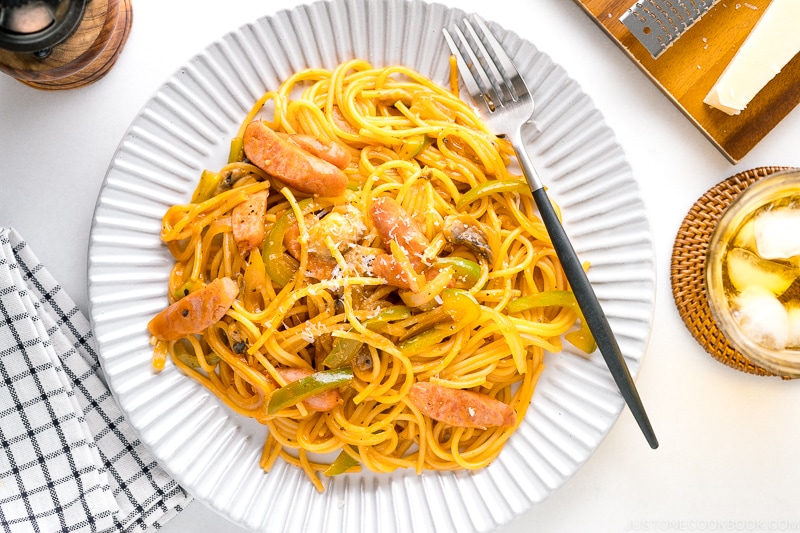Spaghetti Napolitan Naporitan: Discover the Origins And Flavors
Spaghetti Napolitan, also known as Naporitan, emerged in post-World War II Yokohama. Shigetada Irie, the head chef at the New Grand Hotel, combined American soldiers’ rations with Japanese ingredients, creating a unique dish. The name “Napolitan” indicates its Italian semblance, but the flavors bridge Western and Japanese cuisines. Over the decades, the recipe evolved, influenced by local palates and global trends, yet retained its ketchup-centric sauce and sautéed ingredients.
Key Ingredients and Variations
The primary ingredients of Spaghetti Napolitan include spaghetti, ketchup-based sauce, onions, bell peppers, and sausage. Some variations incorporate mushrooms, ham, or bacon, adding depth. You might find versions with Worcestershire sauce, hot sauce, or garlic for added zest. The dish is often garnished with Parmesan cheese or a fried egg, enhancing both its taste and presentation.
How to Make Spaghetti Napolitan Naporitan
Step-by-Step Recipe
- Prepare Ingredients: Chop 1 onion, 1 bell pepper, 100g sausage, and optionally, 50g each of mushrooms and ham or bacon. Cook 200g spaghetti according to package instructions.
- Sauté Vegetables and Meat: Heat 1 tablespoon of oil in a pan. Add onions, bell peppers, sausage, mushrooms, and ham or bacon. Cook for about 5 minutes until tender.
- Add Sauce: Lower the heat. Mix in 4 tablespoons of ketchup. Optionally, add 1 tablespoon Worcestershire sauce and 1 teaspoon hot sauce. Stir until everything’s well-coated.
- Combine with Spaghetti: Toss the cooked spaghetti with the sauce and ingredients until evenly mixed. Cook for another 2 minutes.
- Garnish and Serve: Transfer to a plate. Optionally, top with grated Parmesan cheese or a fried egg for enhanced flavor.
- Use Fresh Ingredients: Fresh vegetables enhance the dish’s flavor. Avoid canned or pre-chopped items for best results.
- Adjust Sauce to Taste: If you prefer a less tangy sauce, reduce the amount of ketchup. For a richer flavor, increase Worcestershire sauce.
- Control the Heat: Maintain medium heat when sautéing. High heat may burn ingredients; low heat may not cook them properly.
- Add Extra Flavor: Rotate in garlic or a pinch of red pepper flakes if you like a bit of a kick. Experiment with different herbs.
- Balance Texture: Ensure the vegetables remain slightly crisp after cooking. Overcooking will result in a mushy texture.
Use these steps and tips to perfect your Spaghetti Napolitan Naporitan, combining classic fusion flavors for a unique dish.
Culinary Significance of Spaghetti Napolitan Naporitan
Impact on Modern Italian Cuisine
Spaghetti Napolitan Naporitan showcases an intriguing blend of Japanese and Western culinary techniques. Despite its Japanese roots, it has influenced modern Italian cuisine, particularly in how non-native dishes can be adapted to local tastes. Recipes often incorporate familiar Italian ingredients like pasta, onions, and bell peppers. This adaptation has broadened the scope of pasta dishes, proving that innovation with traditional ingredients can appeal globally. Factors like simplicity, flexibility, and vibrant flavors make it a notable addition to Italian-inspired menus.
Popularity in Japan
Spaghetti Napolitan Naporitan enjoys widespread popularity across Japan, being a staple in both home cooking and restaurant menus. Its comfort food status is cemented by its easy preparation and familiar taste. You often find it in Japanese cafes, known as kissaten, where it’s served as a classic go-to meal. The dish’s appeal lies in its nostalgic value and the adaptability of its ingredients, which can cater to various dietary preferences.
Pairing and Serving Suggestions
Best Side Dishes
Pairing the right side dishes elevates your Spaghetti Napolitan experience. Salads offer a fresh counterpart to the rich, savory flavors. Simple green salads with balsamic vinaigrette or Caesar salads work well. Bread adds a comforting touch. Garlic bread, baguette slices, or even breadsticks complement the dish’s texture and flavor.
Vegetable sides balance the meal. Sautéed spinach, roasted bell peppers, or steamed broccoli provide a nutritional boost. Pickles or Japanese-style pickled daikon radishes contrast nicely with the sweetness of the ketchup-based sauce. Consider small portions of these sides to create a well-rounded and satisfying meal.
Recommended Drinks
Drinks can enhance your enjoyment of Spaghetti Napolitan. Light beverages suit its taste profile. A crisp white wine like Sauvignon Blanc, with its citrus notes, pairs well. Japanese beers like Asahi or Sapporo offer a refreshing, mild bitterness that cleanses the palate.
Non-alcoholic options also fit perfectly. Green tea adds a subtle astringency, making it an excellent choice. Iced tea or sparkling water with lemon provides a refreshing and versatile option. For a unique twist, try pairing with a fizzy lemon soda, which complements the dish’s sweet and tangy components.
Conclusion
Spaghetti Napolitan offers a unique culinary experience that bridges Western and Japanese flavors. By pairing it with complementary side dishes and drinks you can elevate this comfort food into a memorable meal. Whether you choose a crisp Sauvignon Blanc or a refreshing green tea the right accompaniments can enhance your enjoyment of this delightful fusion dish. So next time you’re craving something different give Spaghetti Napolitan a try and savor the blend of cultures on your plate.






